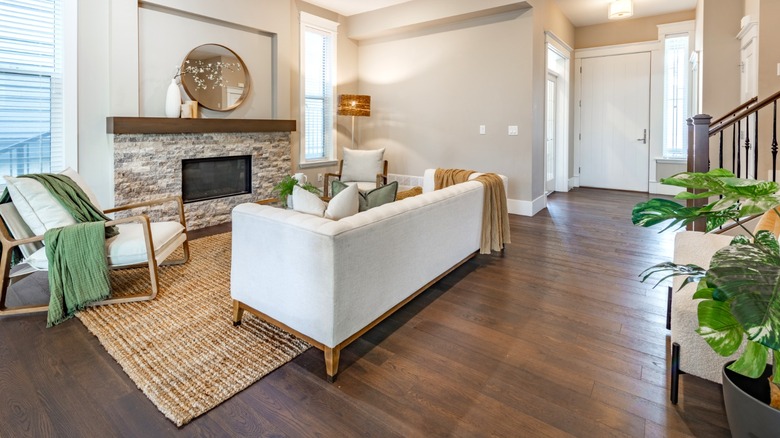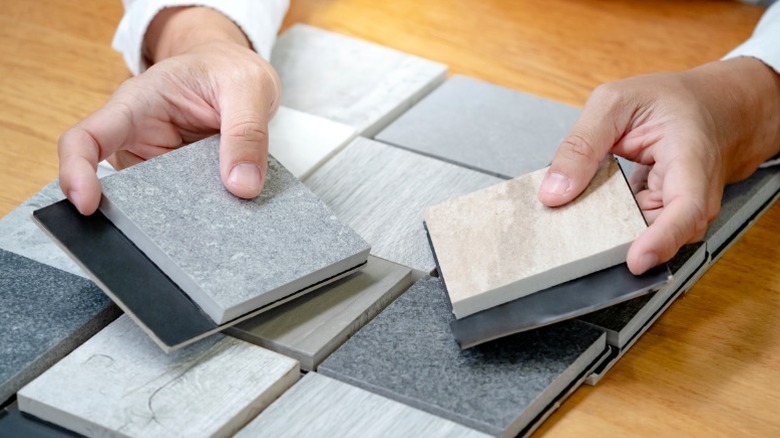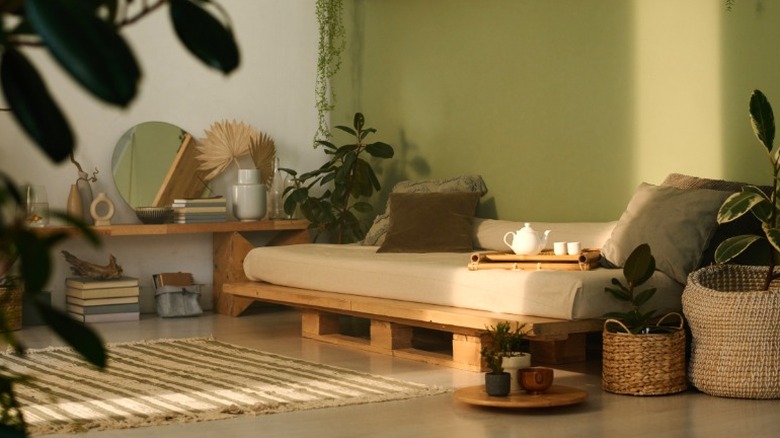The Flooring Trend That Brings Natural Elements Into Your Home
In a world getting more stressful by the minute, it's hardly surprising that homeowners are leaning toward calmer, comforting designs in the areas they can control. What better way to do that than to invite the tranquility of the outdoors into the home? Biophilic interiors are becoming one of today's top trends. By pulling in plants and sustainable features, these styles allow the happiest of marriages between the cozy security of home and nature's proven mental, emotional, and spiritual benefits.
Tying it all together, flooring makes a sensible starting point for a stylish layout. Organic textures like stone and wood offer one-of-a-kind interest to anchor the room. And according to Skylar Bartlett, owner of Kreer Construction, chic biophilic looks like these can fit almost any need or budget. "It's about designing with nature in mind," remarked Bartlett in an exclusive interview with House Digest. "The goal is to create spaces that feel grounded, calming, and connected to the outdoors. While hardwood and stone are common materials, what makes them 'biophilic' is how they're used: in ways that highlight organic patterns, warm tones, and sensory experience."
Luckily, choosing the best flooring based on ease of installation, cost, or durability while staying true to the biophilic ethos is easier than you may expect. "You might still use engineered or vinyl products, but if they replicate natural textures with intention, they can absolutely fall under the biophilic umbrella," she explained. "It's more of a design philosophy than a strict materials list."
Stick with warm wood tones, sandy neutrals, and mossy greens
In her exclusive interview with House Digest, Skylar Bartlett said that biophilic flooring provides unique perks you can enjoy for years. "It might not make an instant visual impact the way bold trends do — but that's part of its charm," she explained. Bartlett also pointed to studies showing the benefits of natural elements on boost and focus. "Unlike a lot of trends, it has a staying power that still feels fresh, even as styles change," she added.
With the timeless character biophilic interiors afford, you should make every effort to avoid common mistakes when choosing hardwood flooring and other natural materials. Bartlett offered simple tips to develop a more soothing ambience with color and texture. "Warm wood tones, sandy neutrals, and mossy greens mimic natural environments better than cooler, gray-washed floors," she said. "Even subtle tone shifts can change how grounded a space feels." For a layered quality that lends itself to a more natural, live-in space, Bartlett recommended matte finishes, hand-scraped wood, or textured vinyl planks. "[That's] what this trend is all about," she said.
The flooring format can further drive a more nature-oriented aesthetic. "Try wider planks, random-length installs, or even curved transitions between materials to reflect nature's asymmetry," Bartlett recommended. More specifically, she described oak as having some of the best hardwood floor colors and grains for this approach. "Oak in soft, natural tones — especially in wider planks with a matte finish — continues to be one of the most popular choices," she said. "It brings in warmth without feeling heavy and pairs well with just about any style."
Trends to inspire your design
If you want something more unconventional than pricey hardwood, Skylar Bartlett revealed some trendy flooring alternatives to check out in her exclusive interview with House Digest. After all, different materials deliver unique benefits, providing some direction for ideal placement. "While bamboo had its design moment years ago, it's starting to reemerge, especially in minimalist, wellness-focused homes," she said, noting that cork's "softness, warmth, and sound absorption" have also been driving its popularity. According to Bartlett, handmade tiles, terracotta tones, or stone-inspired porcelain are popular choices for bathrooms, mudrooms, and laundry areas. "Using the same or coordinating flooring materials from interior spaces to outdoor patios helps blur the line between inside and outside — one of the core principles of biophilic design," she explained.
Fortunately, various biophilic looks are available at attractive price points. It's all thanks to the natural appeal of luxury vinyl planks and tiles that only becomes more authentic with each new product. And low costs aren't LVP's only perk. "For busy households, high-quality LVP with realistic textures is a smart way to get the look of nature without the maintenance," Bartlett explained. "Wood grain patterns in warm tones or soft stone colors are the most popular picks for this style,"
Today's hottest biophilic trends don't stop with the flooring itself. "Biophilic flooring works best when it's part of a bigger picture," Bartlett advised, suggesting that you pair it with natural light, woven rugs, indoor plants, and breathable textiles. As she noted, wool, jute, and seagrass rugs are popular for adding "movement and a grounded, earthy feel." "They've been all the rage as custom stair runners and area rugs — especially with clients who prefer an elevated look," she said.


